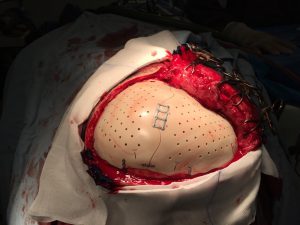Dr. Ramirez attended medical school at the Universidad Autonoma of Guadalajara School of Medicine in Guadalajara Mexico. Dr. Ramirez performed his Neurosurgery training at the National Institute of Neurology and Neurosurgery in Mexico City


Cranioplasty is a surgical procedure performed to restore a cranial defect after a previous surgery where a part of the skull was removed (craniectomy). A craniectomy is usually performed for several problems including traumatic brain injury, ischemic or hemorrhagic stroke or removal of cranial tumors. Brain protection, cosmetics, and improvement of brain functioning are the main indications of cranioplasty.
When a part of the cranium is removed, the brain and other intracranial components are exposed to the effect of the atmospheric pressure, which may cause negative changes in the brain. In the past, the timing of cranioplasty was not an essential factor to consider in patients with craniectomy. However, recent studies have demonstrated that brain functions improve when cranioplasty is performed during the first 3 months after craniectomy. The changes observed in brain functioning include improvement in brain blood flow, improvement in glucose and oxygen metabolism and others. It is reported in the medical literature that a better performance may occur in patient´s cognition when cranioplasty is performed in an early stage.

Figure 1. PEEK Cranioplasty
There two main types of bone graft to use in a cranioplasty, autologous graft (own patient’s bone) and artificial graft. When the autologous bone graft is used, this is usually stored in a freezer or under the abdominal skin of the patient. There are many different materials to manufacture synthetic cranial bone flaps including titanium, methyl-methacrylate, hydroxyapatite, polyetheretherketone (PEEK) and others. The decision in what kind of graft material to use will be based on each patient characteristics. Currently, to increase a better cosmetic outcome, bone grafts are made by computer to manufacture the graft with the exact shape and size. These customized cranial bone flaps are only used with artificial grafts. During cranioplasty, the surgeon carefully cuts the skin of the scalp and gently separate it protecting the dura, which covers the brain. The edges of the cranial defect are cleaned and prepared so the bone graft can be appropriately positioned in the defect. Then, the bone graft is secured to the cranial bones with screws, plates or both (Figure 1). With bone or implant in place, the scalp is moved back to its normal position and the incision is closed. Most cranioplasty patients spend two days in the hospital after surgery. If the surgical site looks ok, you will be discharged and can go home. Although cranioplasty is a prevalent neurosurgical procedure, some complications may occur. These complications include infection, bleeding, bone resorption (autologous graft), sunken cranioplasty and others.

Dr. Ramirez attended medical school at the Universidad Autonoma of Guadalajara School of Medicine in Guadalajara Mexico. Dr. Ramirez performed his Neurosurgery training at the National Institute of Neurology and Neurosurgery in Mexico City

Dr. Ramiro Pérez attended medical school at the University of Guadalajara School of Medicine in Guadalajara México. Dr. Pérez performed his Neurosurgery training in Centro Medico Siglo XXI IMSS and has been practicing his specialty for more than 13 years.

Dr. Nares attended medical school at the University of Aguascalientes, He is trained to perform anterior and lateral approaches to the spine from the cervical to the lumbar spine, as well as minimally invasive surgery.

Dr. Luis Robles has been practicing neurosurgery specialty for 20 years. Dr. Robles is academically active, he participates as a section editor in the World Neurosurgery journal and he has published several articles in different neurosurgery international journals.

